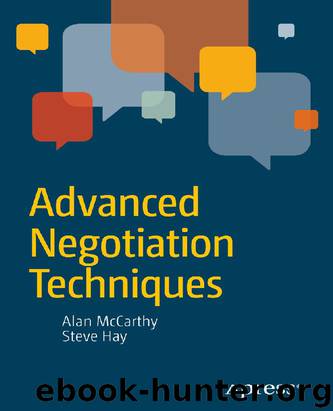Advanced Negotiation Techniques by Alan McCarthy & Steve Hay

Author:Alan McCarthy & Steve Hay
Language: eng
Format: epub
Publisher: Apress, Berkeley, CA
Published: 2020-03-13T16:00:00+00:00
Plan Point 4: Recognition of Common Ground
In most conflicts, positions are often not quite as fundamentally opposed as they may first appear. Even when it seems initially that a conflict is huge and the different parties have wildly competing interests, a landscape may slowly come into focus that indicates there is some common ground to be explored. At certain key points in the negotiation, you will find it useful to have spent some of your planning time trying to identify what that common ground might look like. In particular, you may reach a point in the negotiation when progress appears to have stalled, and you can often get the momentum going again by summarizing the common ground and restating the benefits that both parties can anticipate by resolving the conflict.
In our example, what do we already agree on with the other party? As an absolute minimum, we already agree on three things. First, the customer wants to buy some version of product A. Second, they want to buy it sometime this year. Third, they will pay some price. Now that doesn’t mean to say we’re not in conflict, but when we apply the mantras of cooperation and pragmatism, quite often the common ground helps us to develop the rapport we need for a good “win-win” outcome from the negotiation. As long as we identify the common ground that the customer likes some version of product A, even if they say they want product A++++, this doesn’t mean we have to move into competitive mode. We can still be cooperative and pragmatic, and we can build on this with rapport.
What other possibilities are there for common ground? Your initial research may have indicated some areas for you to explore in your questioning. We’ve already touched on some potential issues such as quality, reliability, scalability, and serviceability; breaking into new markets; and coordinating delivery times to tie in with a shipping schedule for an expansion overseas. Perhaps by the second cycle of planning, your initial discussion will have enabled you to revise plan point 4 to include new common ground that you have identified and that you will then write into the revised plan. This will help you during the next phase of discussion, when you can summarize the new common ground before progressing the negotiation. Use Figure 7-7 to record your initial views about the potential common ground.
Figure 7-7. Fill in common ground
Download
This site does not store any files on its server. We only index and link to content provided by other sites. Please contact the content providers to delete copyright contents if any and email us, we'll remove relevant links or contents immediately.
Hit Refresh by Satya Nadella(9073)
The Compound Effect by Darren Hardy(8867)
Change Your Questions, Change Your Life by Marilee Adams(7676)
Nudge - Improving Decisions about Health, Wealth, and Happiness by Thaler Sunstein(7654)
The Black Swan by Nassim Nicholas Taleb(7052)
Deep Work by Cal Newport(6961)
Rich Dad Poor Dad by Robert T. Kiyosaki(6502)
Daring Greatly by Brene Brown(6471)
Principles: Life and Work by Ray Dalio(6293)
Playing to Win_ How Strategy Really Works by A.G. Lafley & Roger L. Martin(6071)
Man-made Catastrophes and Risk Information Concealment by Dmitry Chernov & Didier Sornette(5951)
Digital Minimalism by Cal Newport;(5697)
Big Magic: Creative Living Beyond Fear by Elizabeth Gilbert(5672)
The Myth of the Strong Leader by Archie Brown(5451)
The Slight Edge by Jeff Olson(5376)
Discipline Equals Freedom by Jocko Willink(5331)
The Motivation Myth by Jeff Haden(5174)
The Laws of Human Nature by Robert Greene(5072)
Stone's Rules by Roger Stone(5050)
